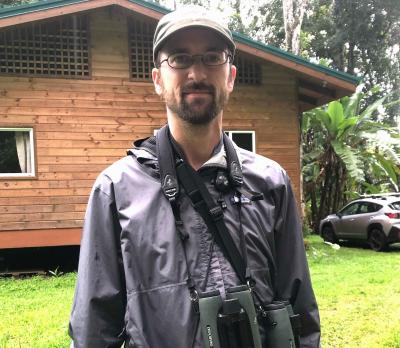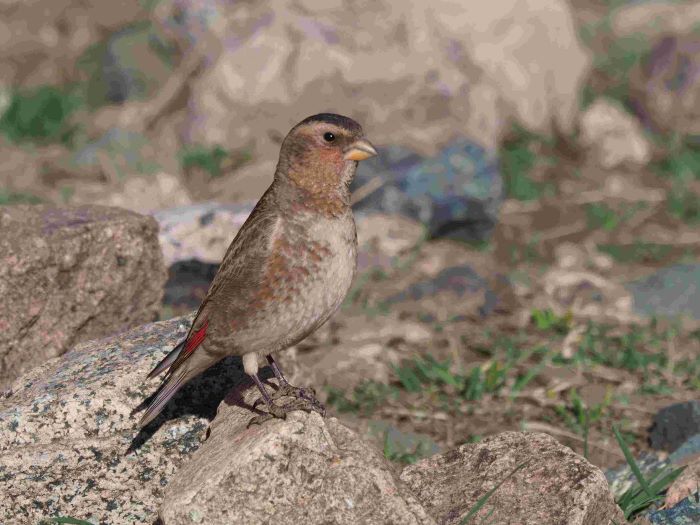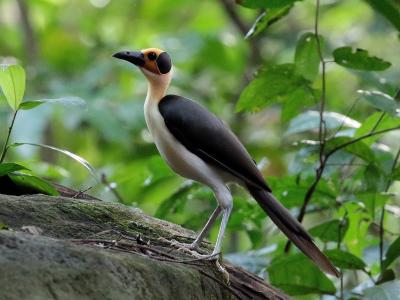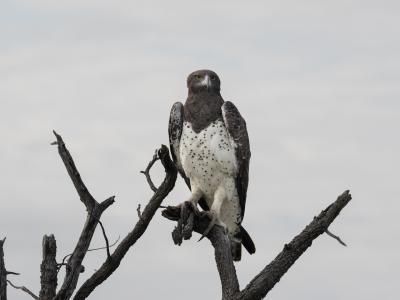Morocco in Spring
-
Mar 21 to Apr 1 2026
Ethan Kistler
-
Mar - Apr, 2027
Ethan Kistler
2026
Single Room Supplement $440
2027
Tour Price to be Determined
2026
Single Room Supplement $440
2027
Tour Price to be Determined
As early spring touches Morocco, the country bursts into life, offering the visiting birdwatcher some truly memorable experiences. We’ll begin in Marrakech before heading into the dramatic mountains of the High Atlas. Here we’ll seek out a variety of mountain birds, and in particular the elusive African Crimson-winged Finch, a species that is probably seen more easily here than anywhere else.
Perhaps most exciting of all will be our trip through the desert areas near Boumalne Dades and Merzouga along the edge of the spectacular Sahara. In this beautiful landscape are more special birds, including such classic desert species of North Africa as Cream-colored Courser, Thick-billed Lark, and Desert Sparrow. We’ll then travel down to the Atlantic coast and Agadir, where we hope to find Northern Bald Ibis, one of the world’s rarest birds, as well as a variety of waterbirds on the Souss and Massa estuaries.
Day 1: The tour begins this evening in Marrakech.
The tour was great and Ethan was a fantastic guide. The scenery and birds were both awesome! This tour takes you through a variety of landscapes that amaze at every turn. - Amanda B.
Days 2-3: From Marrakech we’ll drive south to the Atlas mountains where we have two days exploring this wonderful area. African Crimson-winged Finch is our primary goal, often found amongst flogs of Rock Sparrows and ‘Atlas’ Horned Larks (a potential split). We’ll also see African Blue Tit and the recently split African Chaffinch.
The three countries of Morocco, Tunisia and Algeria make up the Maghreb, and this area has several endemic species/subspecies depending on whose taxonomy you follow. With luck this mountainous terrain will provide us with two of these—Moussier’s Redstart and Atlas Wheatear. The high meadows, sometimes covered in snow even in April, are home to both Yellow-billed and Red-billed Choughs, and Water Pipit and White-throated Dipper may be found nearby. Overhead we may see the local ‘Atlas’ race of Long-legged Buzzards and, having now recovered from years of persecution, perhaps a mighty Bearded Vulture. Nights near Oukaimeden.
Day 4: After an early breakfast we’ll leave the mountains behind, perhaps pausing en route for Levaillant’s Woodpecker. From the flat plains of Marrakech we’ll turn back uphill and make the long, scenic drive to Boumalne via the spectacular Tizi-N’Tichka Pass. As the road climbs into the hills, we may start to see some more raptors, possibly including migrant Booted Eagle and Short-toed Snake Eagles. Before lunch we’ll target another North African endemic, Tristram’s Warbler. If time allows, we’ll make a stop in Ouarzazate to explore the dam at Mansour Edhabbi. Here we’ll have a chance of seeing Blue-cheeked Bee-eater, Eastern Olivaceous Warbler and Maghreb Lark, as well as Ruddy Shelduck, Marbled Duck, Eurasian Spoonbill, and a selection of waders and migrants. Night in Boumalne Dades.
Day 5: We’ll head out before breakfast to explore the famous Tagdilt region. Our targets for the day will include Black-bellied Sandgrouse, Cream-colored Courser, Desert and Red-rumped Wheatears, Trumpeter Finch, and a selection of larks including Greater Hoopoe, Temminck’s, both Greater and Mediterranean Short-toed, and with luck the highly nomadic Thick-billed. At this time of year migration is often evident over the desert as small groups of European Bee-eaters and swifts (both Pallid and Common) work their way north. Night in Boumalne Dades.
Day 6: The scenery will change again today as we leave behind the high, stony desert and travel to a sandier habitat. New birds will continue to appear, with Brown-necked Raven, Bar-tailed Lark, Scrub Warbler, and White-crowned Wheatear all possible. If we’re lucky, we may be able to catch up with Maghreb Wheatear, Pharoah Eagle Owl and Lanner Falcon en route to Erfoud, the gateway to the Sahara. On the edge of the desert, we could see a selection of migrant warblers around the hotel, ranging from Western Subalpine and Sardinian to Western Bonelli’s and Western Olivaceous, as well as Eurasian Wryneck, Eurasian Hoopoe, Bluethroat, Woodchat Shrike, and European Bee-eater. The highly localized Eastern Olivaceous Warbler (race reiseri) sometimes breeds near the hotel. Night in Erfoud.
Day 7: We’ll spend the whole day in four-wheel-drive vehicles exploring this fascinating desert habitat. We’ll be searching for a number of classic desert birds including Desert Sparrow, Bar-tailed and Greater Hoopoe Larks, Spotted and Crowned Sandgrouse, Cream-colored Courser, Desert Grey Shrike, and African Desert Warbler. We also hope to find a beautifully camouflaged Egyptian Nightjar at a daytime roost. Night in Erfoud.
Day 8: We’ll have another long journey today, but not without some birding along the way. Blue-cheeked Bee-eaters are often seen along the route, and we’ll stop at likely looking spots to check for migrants. After another picnic lunch we’ll continue to Ouarzazate where, depending on our arrival time, we may be able to check out the shoreline of the nearby reservoir or bird some of the lush green gardens along the river. Night in Ouarzazate.
Day 9: There will be more time this morning for birding around the reservoir. In recent years this has been a reliable site for Ruddy Shelduck, and migrant waders could include Wood and Curlew Sandpipers, Ruff, Little Stint, and Black-winged Stilt. Passerines will also be present, and careful checking through groups of Yellow Wagtails could produce severak different subspecies as well as the Moroccan White Wagtail—species or not, the latter is a stunning bird to see. Migrant harriers often drift through, with Montagu’s and Western Marsh the most likely, and we may see Greater Flamingo and Black-crowned Night and Purple Herons. Our destination this evening is coastal Agadir, and once away from the reservoir we’ll drive through more mountainous habitat, home to Bonelli’s Eagle, Black Wheatear, and Western Orphean Warbler, stopping in Tazenahkt for a coffee break and the chance to haggle for a carpet to take back home from Morocco’s ‘carpet city’. Night in Agadir.
Day 10: Driving alongside long Atlantic rollers, we’ll head north of Agadir in search of one of Morocco’s most iconic birds, the Northern Bald Ibis. At this time of the year, visiting the breeding cliffs of this endangered species is quite rightly not allowed, but we usually find them in coastal fields, where they can sometimes be very confiding. At nearby Tamri we’ll check the estuary, where the ibis sometimes drop in to bathe, as do hundreds of gulls, often including the increasingly numerous Audouin’s and Slender-billed. If there is an onshore wind, seawatching may produce Northern Gannet, Common Scoter, and occasionally a skua or even a Razorbill. Migrants may include Western Black-eared Wheatear, Tawny Pipit, and Eurasian Thick-knee, while European Serin, Zitting Cisticola, and House Bunting are all common breeders. We’ll spend the afternoon around the Souss estuary, where anything can, and frequently does, turn up. Large wading birds such as Greater Flamingo, Eurasian Spoonbill, and White Stork can be numerous, and we’ll check the gulls and terns for species such as Mediterranean Gull and Gull-billed and Caspian Terns. Waders are often plentiful and the selection ever-changing, from both Bar-tailed and Black-tailed Godwits to Common Greenshank, Black-bellied and Kentish Plovers, and Little Stint. The nearby scrub holds plenty of Maghreb Magpies as well as a special bird widespread throughout Africa south of the Sahara, the striking Black-crowned Tchagra. Night in Agadir.
Day 11: Just as famous as the Souss estuary is the Oued Massa, about an hour south of Agadir. Here the dry-stone walls provide ideal perches for Little Owls, Thekla Larks, and wheatears, and the neatly farmed agricultural areas are excellent for Laughing Doves and European Turtle Doves, as well as Barbary Partridge, “Sahara” Great Grey Shrike, Moussier’s Redstart, and Cirl Bunting. The once brackish lagoon inland of the dunes can hold a variety of waders and herons, and walking along its length provides a great opportunity to scan for raptors, with Osprey, Bonelli’s Eagle, and Black-winged Kite all possible. After lunch we’ll explore more agricultural areas inland where we may find Little Bittern, Squacco and Purple Herons, and Brown-throated Martin, the latter at one of its few Western Palearctic locations. Night in Agadir.
Day 12: The tour concludes this morning at the airport in Agadir.
Note: The information presented here is an abbreviated version of our formal General Information for this tour. Its purpose is solely to give readers a sense of what might be involved if they take this tour. Although we do our best to make sure that what follows here is completely accurate, it should not be used as a replacement for the formal document which will be sent to all tour registrants, and whose contents supersedes any information contained here.
ENTERING MOROCCO: Travelers to Morocco must have a passport valid at the time of entry and with at least one bank page for an entry stamp. Visas are not required for American tourists traveling in Morocco for less than 90 days. For further information on entry requirements for Morocco, please contact the Embassy of the Kingdom of Morocco in the United States: https://us.diplomatie.ma/
COUNTRY INFORMATION: You can review the U.S. Department of State Country Specific Travel Information here: https://travel.state.gov/content/travel.html and the CIA World Factbook here: https://www.cia.gov/the-world-factbook/. Review foreign travel advice from the UK government here: https://www.gov.uk/foreign-travel-advice and travel advice and advisories from the Government of Canada here: https://travel.gc.ca/travelling/advisories.
PACE OF TOUR AND DAILY ROUTINE: Typically we drive to various locations and make fairly short and slow walks from the vehicle. There are several longer strolls (two hours or so). There are a few longer drives (on a couple of days much of the day is spent travelling) but the scenery is always changing and there will be birding stops as and when we see anything of interest. Breakfasts are usually around 7:00 a.m. and are often very simple with coffee, juice, bread and jam. There may be an early start where we return to our hotel for a late breakfast. On some days lunch will be a picnic at a birding site.
HEALTH: The Centers for Disease Control and Prevention (CDC) recommends that all travelers be up to date on routine vaccinations. These include measles-mumps-rubella (MMR) vaccine, diphtheria-tetanus-pertussis vaccine, varicella (chickenpox) vaccine, polio vaccine, and your yearly flu shot.
They further recommend that most travelers have protection against Hepatitis A and Typhoid.
The most current information about travelers’ health recommendations can be found on the CDC’s Travel Health website at https://wwwnc.cdc.gov/travel/destinations/list
Elevation: We reach 2,600m (8,500 feet) in the Atlas Mountains of northern Morocco. The walking here is not strenuous and mostly on level ground. We reach similar altitudes driving over the Tiz N’Tichka pass. The Sahara Desert is a relatively high desert at around 900m asl (3,200 feet) and we’ll spend several days at this altitude, where the weather can be surprisingly chilly in the very early morning.
Miscellaneous: Mild intestinal disorders are difficult to avoid completely and we suggest that you bring diarrhea medication such as Imodium. Water in Morocco is generally safe in the larger towns but we would recommend that you do not drink tap water anywhere on the tour. As an extra precaution, the leaders even use bottled mineral water for teeth-brushing etc. Bottled water, beer and soft drinks are widely available.
We are unlikely to encounter mosquitoes or biting insects except at the Souss estuary, and some of the desert oases and lakes are as much a magnet for insects as they are for birds.
CLIMATE: It is generally warm to hot and dry throughout the year but in spring it can be cooler in the north and very cold in the mountains and desert areas. Temperatures range from 10-15°C (50-60°F) at night to daytime highs of 15-30°C (60-90°F) in lowland areas. In the mountains temperatures are usually 5-10°C (10-20°F) lower but even in March it can be below freezing for most of the day at the ski resort. Rainfall is low in the desert (a shower every four years or so) but moderate in the Atlas (whereas at this time of year it may still fall as snow) and along the coast. We may experience some windy days especially in the mountains and desert which can make an otherwise warm day seem very cold.
ACCOMMODATION: Our hotels are all comfortable, modern hotels with Wi-Fi and en suite facilities.
FOOD: Breakfast usually consists of a simple selection of bread, eggs, jam, orange juice, tea and coffee. Lunch will either be a picnic with fresh bread, cheese, tinned tuna, plus lots of local fruit, olives, cucumber, tomatoes and onions, or we will stop in cafes, offering tajines, brochettes or omelettes, and hopefully on the coast some very fresh seafood. Dinners are often excellent, ranging from tajines of chicken, lemon and olive; or lamb, prune and almond to couscous with lots of local vegetables. In the more touristy areas there will likely be a large dinner buffet.
Drinks: Bottled water and a soft drink or a beer is provided at lunch and dinner, as is coffee or tea. All other drinks or ‘personal’ drinking water for use in your room is the responsibility of the individual. Bottled water is provided in the tour vehicles during the day.
Food Allergies / Requirements: We cannot guarantee that all food allergies can be accommodated at every destination. Participants with significant food allergies or special dietary requirements should bring appropriate foods with them for those times when their needs cannot be met. Announced meal times are always approximate depending on how the day unfolds. Participants who need to eat according to a fixed schedule should bring supplemental food. Please contact the WINGS office if you have any questions.
TRANSPORTATION: The transport for the tour will be by minibus or small coach. On one day in the desert we will transfer to 4x4s. We will not cover large distances in these vehicles but they are essential to reach some of the key birding sites. Participants should be willing and able to ride in any seat in the tour vehicles.
2025 Narrative
The tour began on the outskirts of Marrakech with a short pre-breakfast walk outside our hotel, quickly yielding our first birds. House Buntings sang from the hotel walls, Spotless Starlings darted past, and a distant Maghreb Magpie flew over a barren lot.
Leaving the vibrant city behind, we began our ascent into the stunning Atlas Mountains. Each twist and turn revealed breathtaking views of hillside villages, sweeping vistas, and roadside stalls brimming with pottery and earthenware. Our first stop was a patch of mixed coniferous plantation which provided plenty of singing Common Firecrests, several cooperative Short-toed Woodcreepers, a couple pairs of the “Atlas” subspecies of Coal Tit, noisy Mistle Thrushes, our first of many Common Chaffinches, the North Africa subspecies, a male Black Redstart, and a small flock of Yellow-billed Choughs overhead. The real treat was a very vocal Levaillant’s Woodpecker that sat out in the open for us while a second one called nearby.
At our hotel, where we would stay for two nights, we enjoyed some casual birding around the grounds while lunch was prepared. The garden hosted Eurasian Blackbird, European Serin, Cirl Bunting, African Blue Tit, and Great Tit, while the stream below attracted Eurasian Blackcaps, European Robin, and Common Wood-Pigeon. A European Greenfinch made a brief flyover appearance.
After lunch, we ascended above the thick fog, breaking through the clouds to reach the high-altitude village of Oukaïmeden. Famous for its birding, the area quickly delivered many of our targets. In the parking lot, we were greeted by ‘Atlas’ Horned Larks, joined by a few Rock Sparrows. Nearby, we spotted our main prize—the stunning Crimson-winged Finch. Black Redstarts were abundant, and we enjoyed incredible views of the recently split Atlas Wheatear.
A short drive took us to another productive birding spot, where we picked up Moussier’s Redstart, Common Raven, and Rock Bunting. A nearby stream yielded a White-throated Dipper almost immediately, followed by other highlights such as Eurasian Crag-Martin, Eurasian Wren, Black Wheatear, and Meadow Pipit.
To cap off an already outstanding day, we had exceptional views of a Maghreb Owl right outside our rooms, watching it for an extended time and even capturing some great photos.
The following morning, we returned to Oukaïmeden in search of a few species we had missed the day before. With the weather much improved, we were greeted by several Blue Rock-Thrushes—new additions to our trip list. After some persistence, we successfully located two Alpine Accentors. We also enjoyed repeat views of species seen the previous day, including Crimson-winged Finch, White-throated Dipper, and Atlas Wheatear, and we also added our first Gray Wagtail to the list.
As we descended the mountain, we picked up an “Atlas” Long-legged Buzzard en route. Following lunch, we explored a nearby road winding through beautiful juniper-oak woodlands, where we came across a group of about six “North Africa” Red Crossbills. A couple individuals offered fantastic views, posing nicely for the group. Later in the afternoon, we added Common Chiffchaff, “Atlas” Great Spotted Woodpecker, and Sardinian Warbler to our tally.
The next morning, we descended into the Ourika Valley, birding a series of rocky fields along the way. Highlights included Great Gray and Woodchat Shrikes, European Stonechat, Corn Bunting, and an especially cooperative Barbary Partridge. From there, we continued through the scenic Tizi N'Tichka Pass and enjoyed a memorable lunch in the remote highlands.
In Ouarzazate, we spent an hour scanning the reservoir just outside the city. Careful observation turned up a nice mix of species, including Ruddy Shelduck, Little Ringed and Kentish Plovers, Common Sandpiper, Common Redshank, Gull-billed Tern, Great Crested Grebe, Great Cormorant, Little Egret, and Gray Heron. The surrounding tamarisk scrub was equally productive, yielding Eastern Olivaceous, Western Bonelli’s, and Western Subalpine Warblers, as well as White-crowned Wheatear. Along the shoreline, both Western Yellow and White Wagtails foraged away.
We spent the remainder of the afternoon completing our drive to Boumalne Dades, where we settled in for a two-night stay at a stunning hotel overlooking the Dades River valley.
Well rested, we set out the next morning for the renowned Tagdilt Track—one of Morocco’s prime locations for larks. We were quickly rewarded with an impressive variety: Thekla’s and Temminck’s Larks scurried around us, while flocks of Greater Short-toed Larks passed overhead. A particular highlight was watching a pair of Greater Hoopoe-Larks perform their dramatic display flights, spiraling upward before diving steeply back to the ground. We also encountered numerous Northern Wheatears, a few Black Wheatears, and a couple of Tawny Pipits.
Continuing on, we reached another promising site where we soon located several good flocks of Black-bellied Sandgrouse. While admiring these desert specialists, we also picked up a few Cream-colored Coursers and Red-rumped Wheatears. A nearby lush farm added some variety, producing a number of species including a vocal Common Nightingale.
Back in Boumalne Dades for lunch, we were treated to an unexpected bonus—a pair of Bonelli’s Eagles circling over the city. After enjoying some delicious tagines, we made our way into the dramatic Dades Gorge in search of a very special bird: Tristram’s Warbler. This North African endemic favors maquis-covered hillsides, and with only modest effort, we were rewarded with incredible, point-blank views of a stunning male just yards away.
Still elated, we returned to town and birded the lush gardens lining the Dades River valley. The area was teeming with both migrants and resident species, including our first Tree Pipits. After dinner, a short drive brought us to the edge of a grove where at least four Eurasian Scops-Owls were calling. With some patience and a spotlight, we managed good views of one individual to round off an exceptional day.
The following morning, we visited a local herder who monitors several key species along a stunning escarpment. Our first highlight was an active Pharaoh Eagle-Owl nest, which held two chicks. We were also fortunate to spot both the male and female roosting nearby. The excitement continued with excellent views of Desert Lark, “Maghreb” Mourning Wheatear, Trumpeter Finch, and a pair of nesting Lanner Falcons.
Before moving on, we had one final target for the area—the impressive Thick-billed Lark. After a thorough search, we were thrilled to finally locate two individuals, making for a very satisfying conclusion to the morning’s birding.
After lunch, we headed to a dry, open region punctuated by a line of shrubs—ideal habitat for Scrub Warbler. It took about an hour of searching, but our persistence paid off when we found four of these charismatic birds, moving low through the brush and occasionally hopping along the ground. We also picked up our first Bar-tailed Larks in the area.
Following this string of successes, we made our way toward Merzouga and checked into our hotel, which offered stunning views of the towering Erg Chebbi sand dunes just steps away. Famous as a filming location for several Hollywood productions, the dunes provided an unforgettable backdrop—and promised spectacular sunsets and sunrises to come.
The next day, we switched to 4x4 vehicles, giving us better access to some of the region’s most remote and arid birding hotspots. Our first stop was a traditional sandgrouse drinking site, where we were treated to excellent views of over 50 Spotted Sandgrouse and around 15 Crowned Sandgrouse—offering great opportunities for comparison and close-up observation.
We then visited a remote desert camp known for hosting nesting Desert Sparrows. These pale, desert-adapted relatives of the House Sparrow are both attractive and distinctive, and we were fortunate to get good views of a pair. A Western Marsh-Harrier made a brief flyby, while a group of at least 10 noisy Rufous Chatterers worked the nearby date palms.
The rest of the morning was spent targeting a few specialties, yielding excellent views of African Desert Warbler and, in a major highlight of the trip, a pair of Egyptian Nightjars resting in the open.
In the afternoon, we explored several gardens, which added a nice variety of migrant and breeding species to the list. Notable sightings included European Turtle-Dove, Blue-cheeked Bee-eater, Willow Warbler, Greater Whitethroat, European Pied Flycatcher, and Common Redstart.
The following morning was primarily a travel day as we began our journey westward toward Ouarzazate. Along the way, we made several brief stops to stretch our legs and take advantage of birding opportunities. These pauses yielded sightings of Western Black-eared Wheatear, Spanish Sparrow, and both Common and Pallid Swifts. We also took time to explore the dramatic Todra Gorge, a geological wonder and scenic highlight of the region.
With some extra time in the late afternoon, we enjoyed a short walk behind our accommodation. This produced our first Tree Pipits of the trip, along with nice views of European Serin, Western Subalpine Warbler, Eurasian Hoopoe, and several other familiar species.
Before breakfast, we enjoyed another walk through the gardens behind our accommodation, which proved productive once again. Highlights included a Zitting Cisticola and a surprise Little Owl perched conspicuously on a post—an excellent start to the day!
Next, we headed to the Drâa River, where we were immediately greeted by a pair of Bonelli’s Eagles circling overhead as we stepped out of the vehicle. The birding along the river was fruitful, with Sedge Warbler, Common Reed Warbler, and a couple of Western Orphean Warblers all new additions to our list. We also noted had the chance to study a Spanish x House Sparrow hybrid. The standout moment was watching a pair of Water Rails show well. Unfortunately, only Ethan and one other caught a glimpse of a Little Crake, a rare and sought-after species in Morocco.
Much of the afternoon was spent traversing Morocco as we made our way toward the Atlantic coast. En route, we stopped at a location known to host Rufous-tailed Scrub-Robins in previous years. While the scrub-robins proved elusive, we were rewarded with a surprise encounter: two Red-necked Nightjars flushed from cover and landed in view, allowing for excellent scope views. In the end, a couple in the group managed quick views of a scrub-robin.
On our second-to-last day in Morocco, we departed our hotel in Agadir and made our way north to the Tamri River estuary region. Just inland, we successfully located one of the trip’s most sought-after species: a group of several dozen Northern Bald Ibis. As we stood quietly, the flock gradually approached, feeding calmly and passing right in front of us—offering absolutely superb views of this globally endangered species.
The estuary itself hosted a nice selection of shorebirds and gulls, including Kentish Plover, Dunlin, and Common Sandpiper, along with Audouin’s, Yellow-legged, and Lesser Black-backed Gulls, plus several Sandwich Terns.
We then visited a nearby coastal promontory for a productive seawatch. Highlights included two Whimbrel, a Ruddy Turnstone, a couple dozen Sanderling, and at least 50 Cape Gannets. The standout, however, was a group of ten Common Scoters—a good find for Morocco.
In the afternoon, we birded the mouth of the Oued Souss, carefully working through large flocks of gulls, shorebirds, and waterbirds. Black-winged Stilts were abundant, and we added our first Eurasian Curlews and Common Greenshanks to the trip list. Diligent scanning through the gulls turned up six species, including our first Black-headed and Mediterranean Gulls, and notably, a first-cycle Ring-billed Gull—a rare vagrant in Morocco. Other highlights from this site included Greater Flamingo, “Moroccan” Great Cormorant, Glossy Ibis, Eurasian Spoonbill, and a Peregrine Falcon.
Sadly, our final day of birding had arrived. We headed south toward Souss-Massa National Park, one of Morocco’s premier birding sites. We spent the morning exploring this productive area, which yielded our highest single-site species total of the tour.
Waterfowl were particularly well represented. Highlights included our first Common Shelduck, Northern Shoveler, Green-winged Teal, Marbled Duck, and a vagrant pair of Blue-winged Teal. In addition to the ducks, we had excellent views of several Black-crowned Tchagras, a regional specialty, and enjoyed a vibrant showing from Sardinian Warblers, Moussier’s Redstarts, European Stonechats, and our first Eurasian Linnets.
Not far from the park, we searched for Mediterranean Short-toed Lark and were quickly rewarded with a couple individuals performing their distinctive aerial displays. After lunch, some final target birding proved fruitful, adding Ruff, Plain Martin, Bank Swallow, Bar-tailed Godwit, Little Grebe, and Western House-Martin to our growing trip list.
We concluded the day—and the tour—back at the Oued Souss, where our previously spotted Ring-billed Gull was still present. The site also delivered a few final new additions, including our first Pied Avocets, Spotted Redshanks, and Slender-billed Gull. It was a fitting and satisfying end to an incredibly successful tour, with all of our major targets seen along with excellent company.
Ethan was simply superb and we cannot wait to book another tour with him. He has boundless energy, enthusiasm and is extremely attentive to the needs of all participants.
- JC B. on Morocco in Spring
Ethan is an outstanding birder and steward of the environment. Did a lot of preliminary scouting at our destinations before arrival of the group and made some adjustments to the itinerary to make sure everything was in order for the tour. He made an extra effort to look out for COVID-related health concerns, such as getting us to meals early to avoid crowds and looking out for use of masks in appropriate settings. Engaging conversations about his unique experiences in birding and conservation.
- Valerie B. on Morocco in Spring
The tour was great and Ethan was a fantastic guide. The scenery and birds were both awesome! This tour takes you through a variety of landscapes that amaze at every turn.
- Amanda B. on Morocco in Spring
Transfer back to the Marrakech airport from Agadir (where the tour concludes) is available.
Maximum group size 9 with one leader.



































